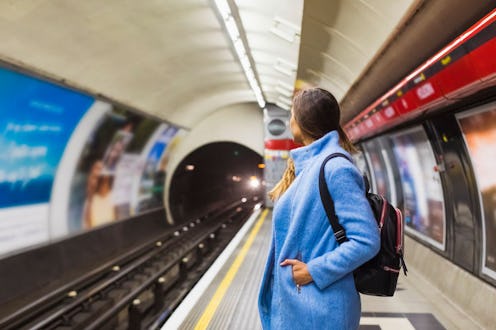Life
7 Public Transport Habits That Could Be Signs Of An Anxiety Disorder

There's very little about public transport that's actively enjoyable: it's overcrowded, under air-conditioned, and all too prone to delays on the sole morning you slept in for an extra ten minutes. On a bleaker note, it's too often the site of harassment or abuse, especially for people belonging to marginalised communities. But there's a crucial distinction between disliking or distrusting public transport, and experiencing symptoms of anxiety while travelling on it. Find yourself constantly hovering by the bus doors, or thrown into panic by a tube delay? Some behaviours on public transport may indicate an anxiety disorder, something a doctor or therapist could help you to manage.
It's far from unusual for people with anxiety to find public transport problematic: journalist Rachel England wrote about her struggle with the Tube in Grazia, for instance, while British transport bosses held a conference in 2016 to discuss how best to ameliorate travel difficulties faced by those with mental illnesses, as reported by Buzzfeed. But it doesn't have to be an inevitable aspect of your journeys: for related anxiety disorders including agoraphobia and panic disorder, the NHS recommends treatment options including talking therapies, medication, and self-help techniques. Wondering if your travel habits might suggest you're dealing with anxiety? Read on for a few potential indicators.
1You Always Stick By The Exits
Say there are plenty of seats on the top deck of the bus, and you've got a thirty minute journey — do you sit down, or do you stand by the doors downstairs, no matter how much your feet ache? According to Patient, a fear of being in a place "where there is no easy exit" is a common symptom of agoraphobia (an anxiety disorder which extends beyond being unable to leave the house). If you're terrified of being pushed deeper into the tube carriage, or you'll only sit at the very front of the bus, you could be dealing with an anxiety disorder.
2You Plan Your Journeys Meticulously
Imagine you're going to meet a friend across town: do you take the first route Citymapper suggests, adjusting only for delays? Or do you spend far longer figuring out which routes will keep you underground for longest, or set off earlier than you need to so you can walk instead of taking the tube? If the latter sounds like you, it's possible you're dealing with an anxiety disorder — like agoraphobia, which the NHS suggests can extend to a fear of "travelling on public transport".
3You Constantly Fear The Worst
So your train's stopped in a tunnel, or it's edging along the track at a third of its normal pace. Do you roll your eyes and begin composing a disgruntled tweet to TFL, only to be thwarted by the lack of signal? Or do you immediately assume that the train, and all its passengers, are on the precipice of disaster, or that you'll be trapped in the tunnel forever? PsychCentral calls this leap to the worst case scenario "catastrophic thinking"; it's a common aspect of anxiety, and worth speaking to a doctor about.
4You Sweat More
Yes, it's summer, and yes, the tube/bus/tram/metro aren't always the most fragrant of places as a result. But "excessive sweating", according to the NHS, can also be a sign of an anxiety disorder (and to complicate matters, overheating can also trigger anxiety attacks, Insider reports). If you find your palms are slicker and your shirt is stickier after stepping onto the bus — no matter the temperature outside — consider speaking to a medical professional to figure out how to proceed.
5You Feel Like You Can't Breathe
As part of its #PrioritySeatingWeek initiative, Transport for London shared the story of a woman named Claire whose anxiety is exacerbated by the Tube. "The noise and the heat, and the lots of people suddenly — I feel like I can't breathe, like everything's closing in on me, and if I don't sit down I'm going to faint." If this sounds familiar, your should seek extra support, and not be afraid to seek it from those around you when underground.
6You Have Other Physical Symptoms
If you experience any physical symptoms of anxiety specifically when you're on public transport — Mind lists "a churning feeling in your stomach", "pins and needles", and "a fast, thumping or irregular heartbeat", amongst others — you could be dealing with generalised anxiety disorder. It may be a good idea to make an appointment to chat with your GP.
7You Get Off Early
Maybe you're struggling to breathe, or you can't get a seat by the door — or maybe you're experiencing all six of the difficulties listed above. For people with anxiety disorders, public transport can quickly become overwhelming, and it's unsurprising that many elect to just get off the train. If you're constantly having to cut your journeys short, or it's beginning to interfere with your daily life, consider an appointment with a doctor or therapist to figure out methods that might help you cope.
It's well-established: public transport can be miserable. But if it's a constant source of fear or dread, if you can't make a plan without fretting about how you'll get there, or if your journeys are characterised by avoidance and anxiety, resist the temptation to simply accept it as an aspect of your life. Anxiety disorders are illnesses, for which there is treatment available. You deserve not to travel in panic.